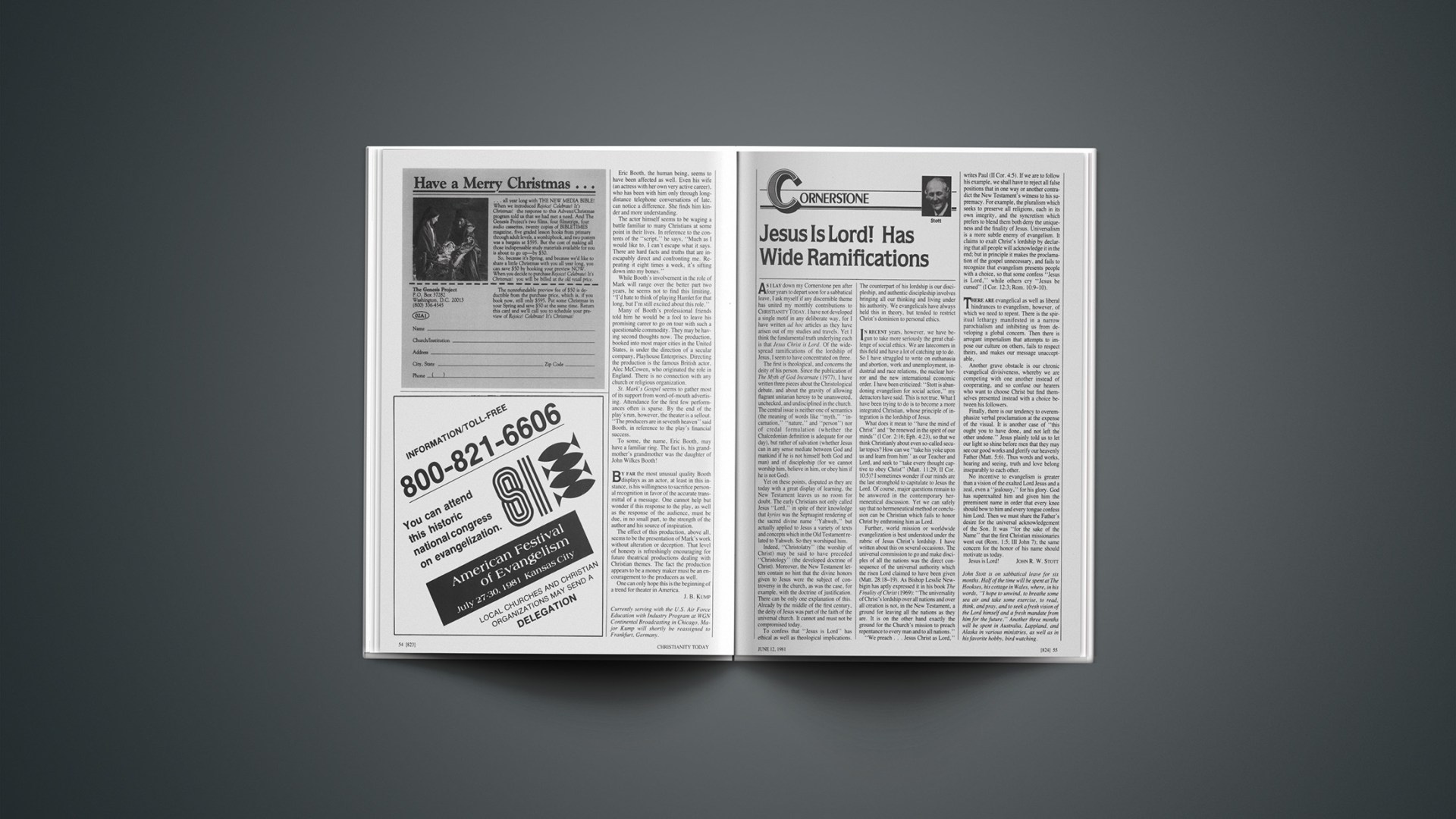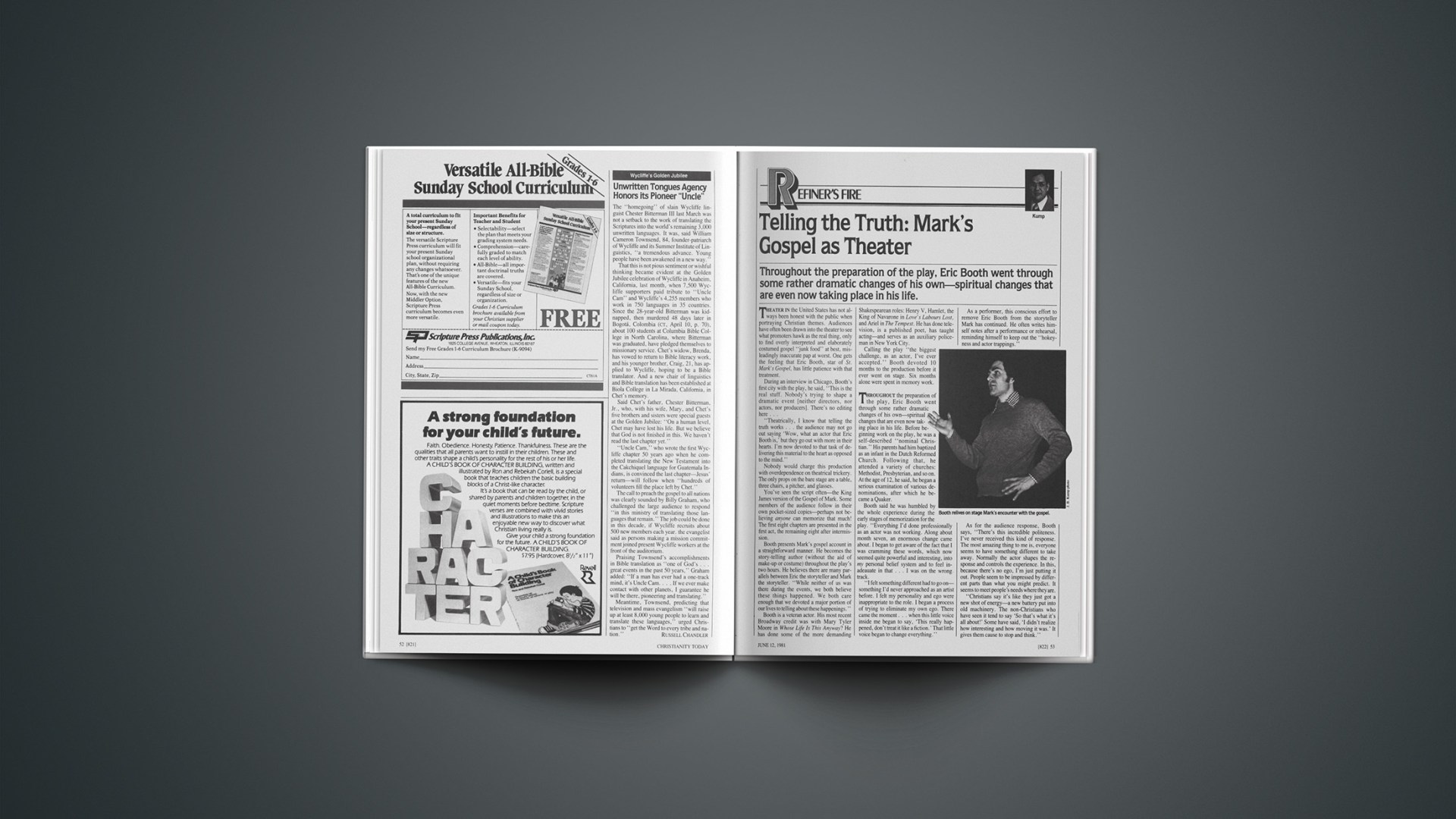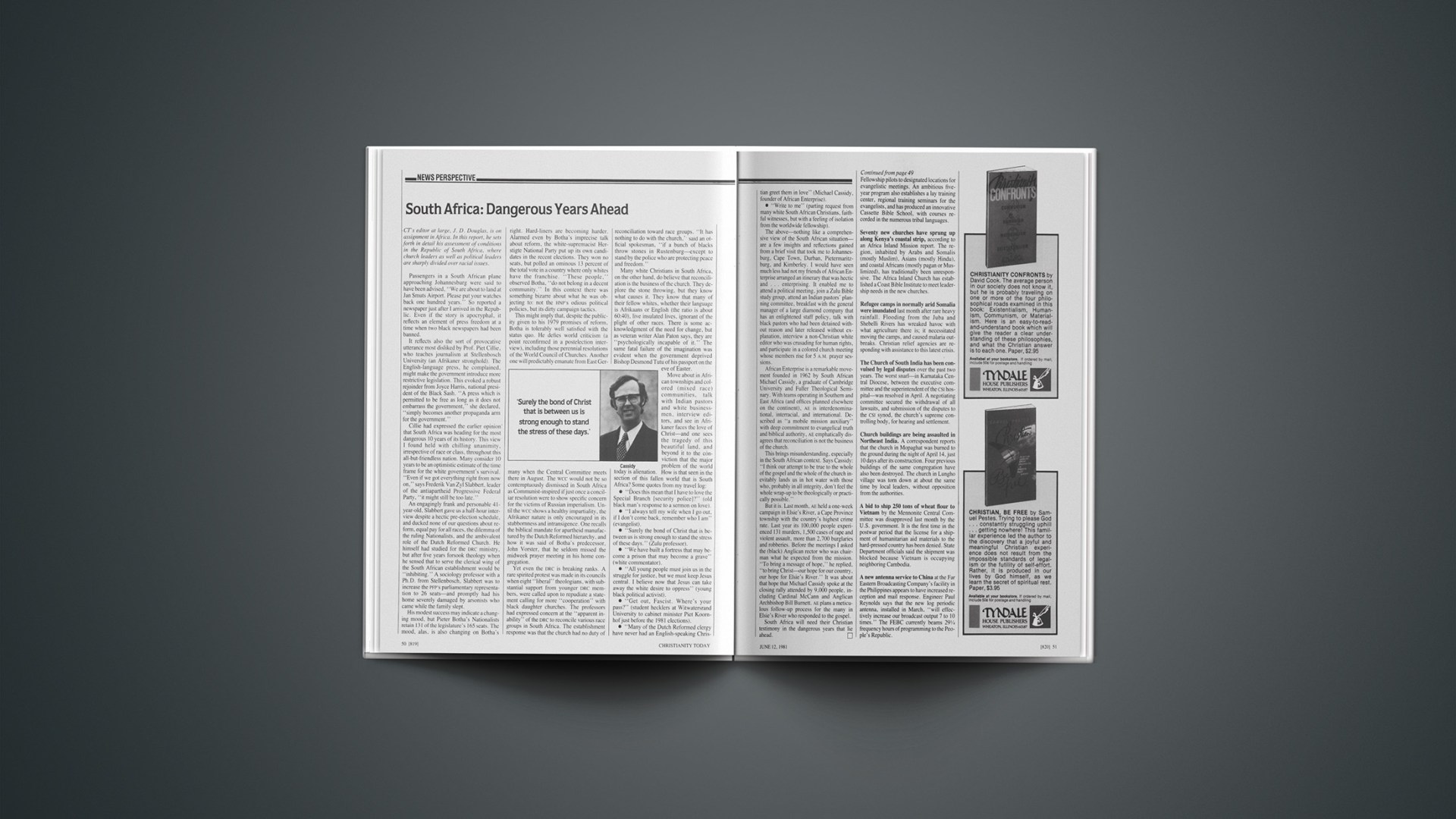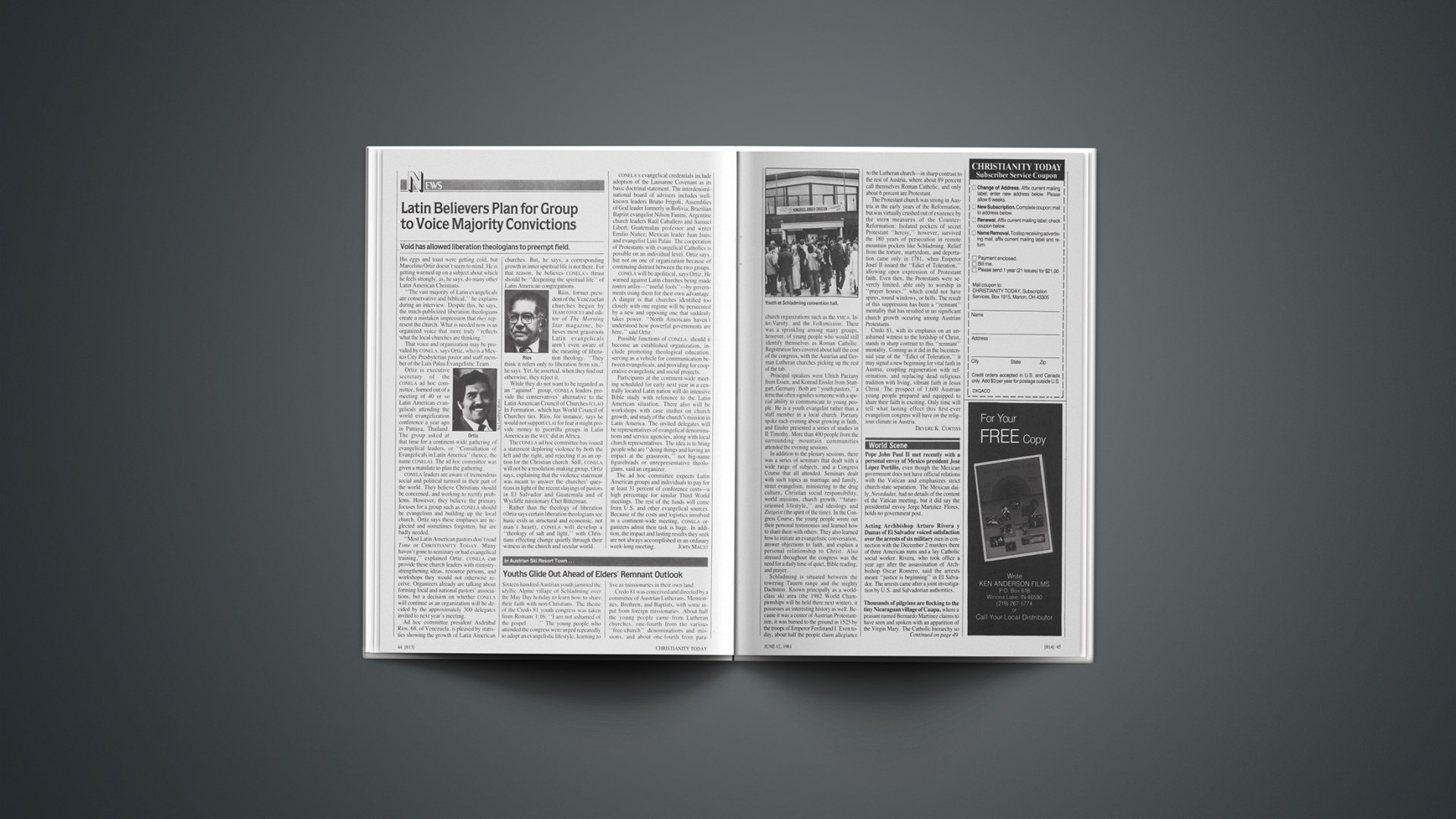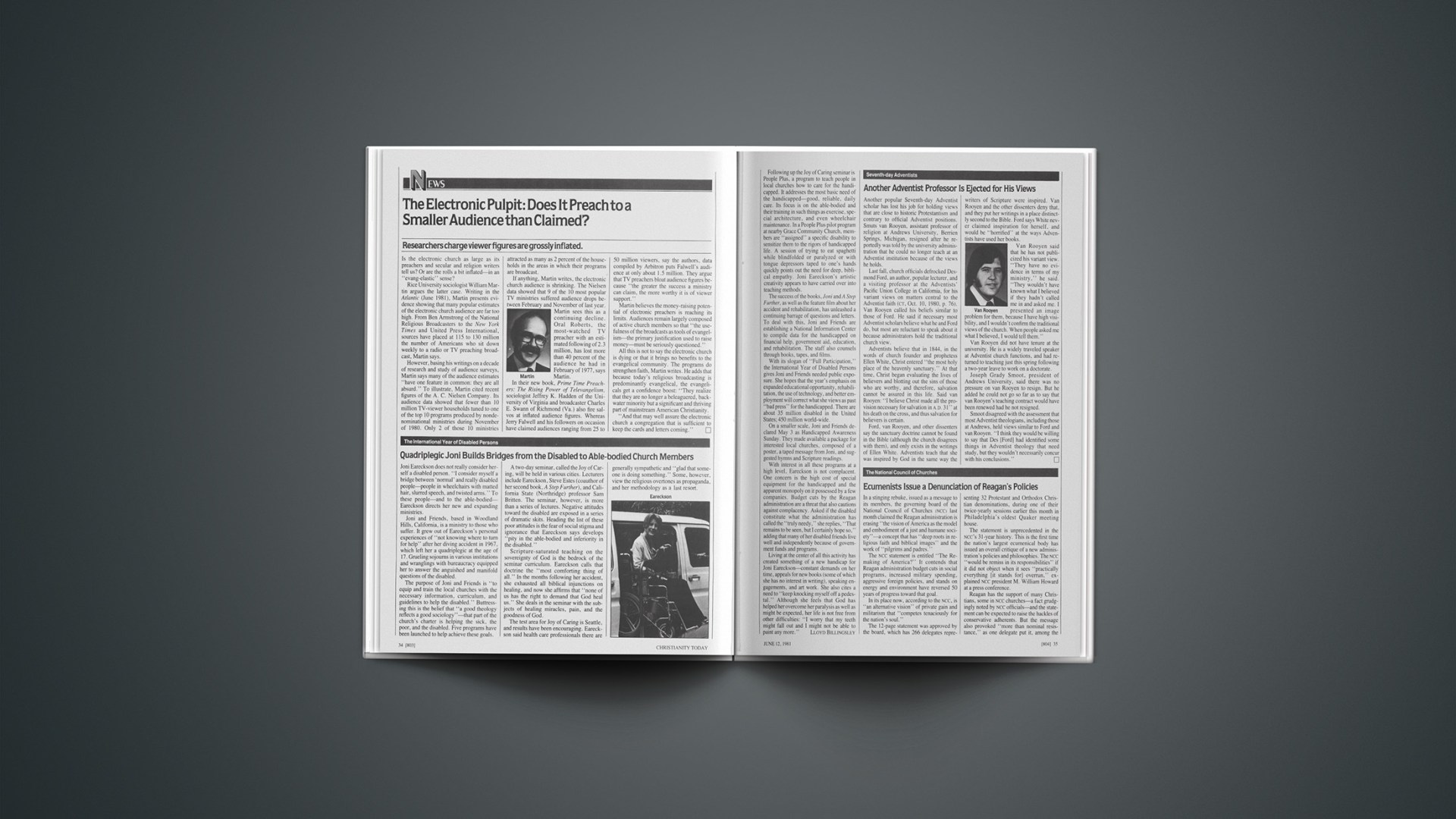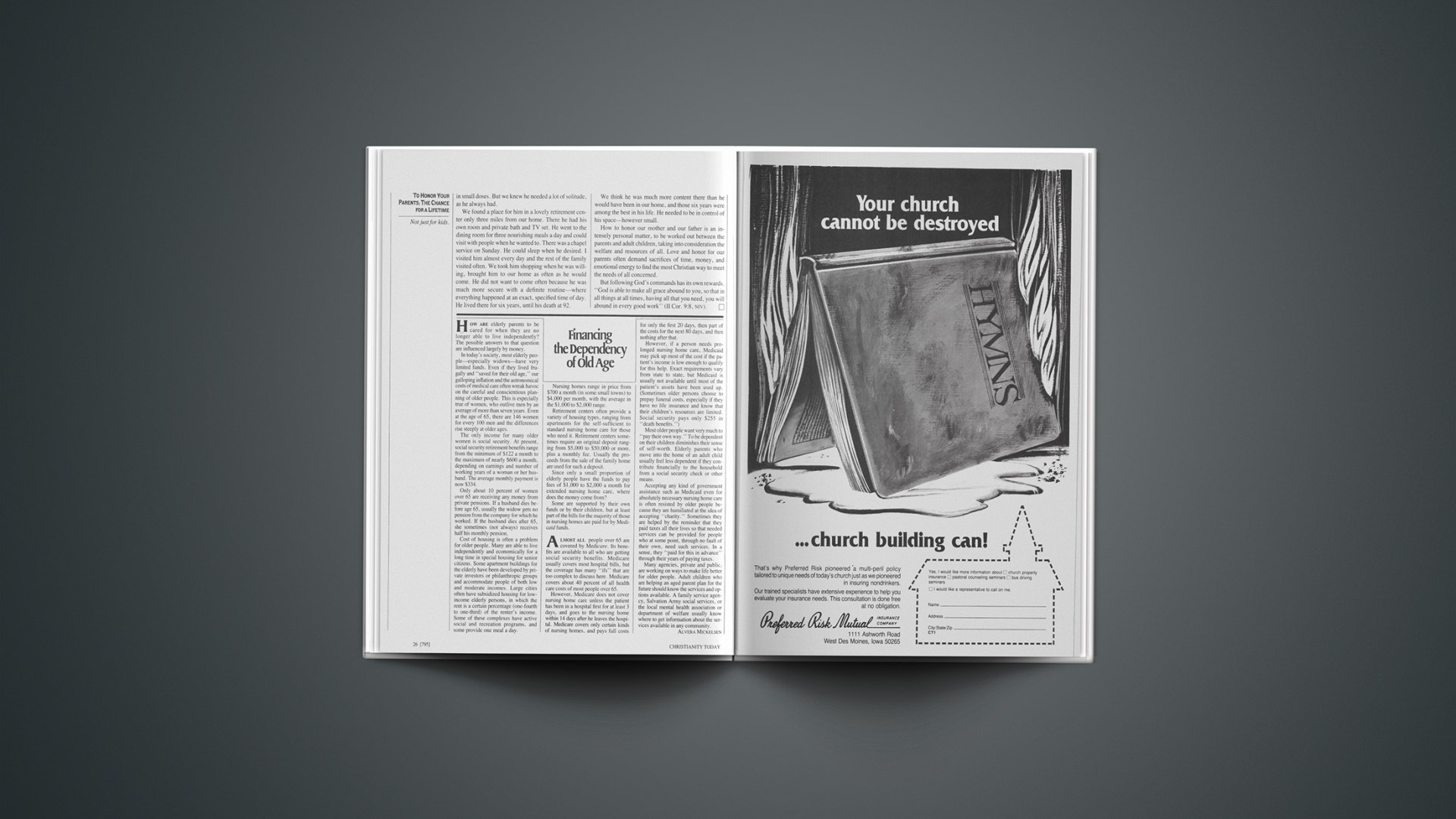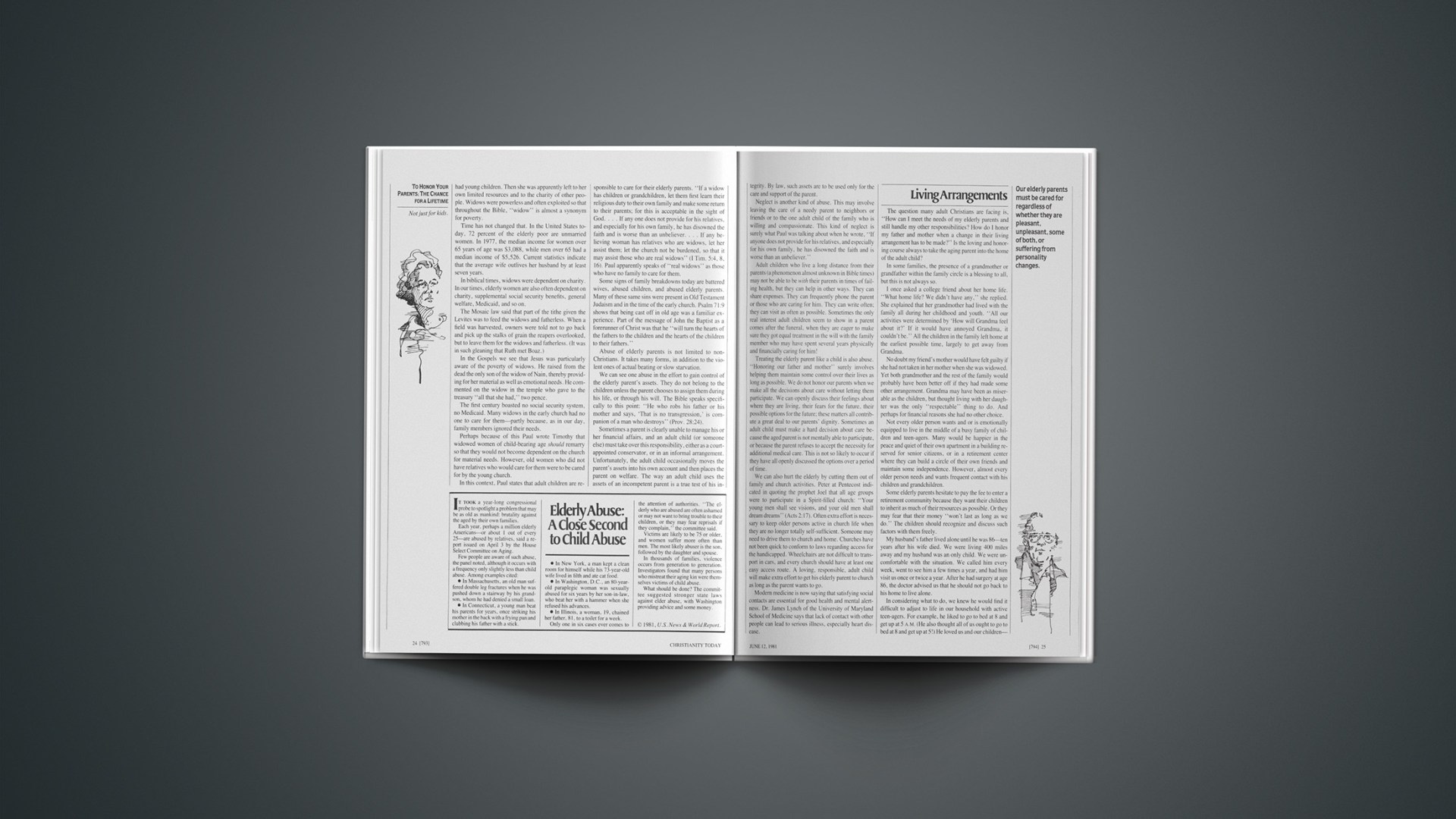Manmade Men
Cloning: Miracle or Menace?, by Lane P. Lester with James C. Hefley (Tyndale, 1980, 156 pp., $4.95), is reviewed by Martin LaBar, chairman, division of science, Central Wesleyan College, Central, South Carolina.
In 1978, Science writer David Rorvik’s book, In His Image: The Cloning of a Man, drew wide public attention to the possibility of asexual reproduction in humans. This was followed by the 1978 birth of Louise Joy Brown, the “test-tube baby,” and a 1979 report of successful transplantation of human nuclei into human egg cells (no attempt was made to place these eggs into a uterus). In January of this year, the first successful experimental asexual production of adult mammals (mice) was announced. The rapidity of these developments makes it appear that humans may soon be born who have only one genetic parent.
People of many religious and philosophical persuasions have examined the wisdom and propriety of extending nuclear transplantation techniques to humans. Cloning is the only book on the subject written from an evangelical Christian perspective. As such, it fulfills a definite need. The book is written clearly, is physically well-produced, and would be easily understood by the general public. Lester, a geneticist at Liberty Baptist College (Lynchburg, Va.), and writer James C. Hefley have produced a book that shows an understanding of science and scientists, does not claim to have all the answers, and demonstrates a reverence for God’s Word. Possible reasons why human cloning might be of use are presented and dismissed, and the book comes to the conclusion that there are no substantial benefits to be gained from human cloning.
Conversely, Cloning discusses the substantial dangers present if it is used. Principally, Lester and Hefley argue, cloning bypasses God’s plan for the family. Also, there would be losses of potential human beings during the development of the technique. In addition, we would expect psychological harm to at least some of the humans produced asexually—both because they were “copies” of someone else, and because of publicity. The authors assume that if clones are produced, God will give them souls, so “soullessness” is not raised as an objection.
Unfortunately, Cloning has some serious flaws. The authors have made some errors of fact, which, while they do not affect the argument, detract from its credibility. The book is not only about cloning, but about humanism, evolution, genetic engineering, eugenics, and other matters. Some good books have been written about these things, and Cloning suffers by comparison. Also, the tone is strident enough at times to turn off some potential readers. There are, for instance, born-again Christians who do not believe all abortions to be wrong.
The book’s lack of depth makes it possible to deal with a lot of issues. It also means there is not as much information about cloning (or other subjects mentioned) as a serious reader would require. Specific gaps include no proposals for preventing the development of the technique, and no analysis of the legality of cloning.
I sum up with a quotation. One of life’s little ironies, considering all Lester and Hefley said about humanists, is that it is not from Cloning, but from The Cloning of Man (New American Library, 1978), which is more complete, cheaper—and by self-confessed humanist Martin Ebon: “Any effort to clone a human being, to create a man-made man, is, in my opinion, immoral, tragic and totally unnecessary.”
Marriage: Priorities And Problems
Straight Talk to Men and Their Wives, by James Dobson (Word, 1980, 217 pp., $8.95), is reviewed by Stanley Clark, pastor, Huntsville Bible Church, Huntsville, Texas.
Doctors are not usually prophets. Dr. James Dobson dons prophet’s garb, however, when he writes, “The Western world stands at a great crossroads in its history. And it is my opinion … that our very survival as a people will depend on the presence or absence of masculine leadership in millions of homes.” And with that he sets out to deliver some Straight Talk to Men and Their Wives.
Dobson is equipped to deliver the message. As a father and child psychologist, he has a personal and professional grasp of the problems confronting homes today. But more important, his wisdom and convictions are rooted in an excellent spiritual heritage that surfaces throughout the book.
Dobson takes aim at two things: priorities and problems. To him the ultimate priority of a Christian father is to “pass the baton” of salvation and spiritual convictions to his own children without dropping it. The problems are the temptations the world is hurling at men (and women) which distract them from that priority: the temptation to place job above family, to become overscheduled, to seek happiness in material things, to live for self, to philander with one’s secretary, and so on.
Every father and husband will find himself mirrored in this book—to his great conviction. For that reason, it is an excellent tool for communicating biblical truth in a style that is not preachy to those men who need a nudge to live the truth they know. The book could be a gift for husbands and wives to read together, a topic to build a Sunday school class or preaching series around, or the basis for a retreat or seminar on the home.
Real Manhood?
The Mark of a Man, by Elisabeth Elliot (Revell, 1981, 176 pp., $7.95), is reviewed by Shirley Stephens, an author who lives in Nashville, Tennessee.
The Mark of a Man consists of 44 short chapters. These seem to be a series of articles put together in an effort to develop the theme of what it means to be a real man in the biblical sense. The book is addressed to Pete, a nephew of the author. She proposes to challenge him to be a real man and to tell him what is involved in reaching that goal. In the introduction, she tells Pete that her wish for him and two other nephews is that “God will make you real men and give you for wives—if He wants you to marry—real women” (p. 9).
Although the book is titled The Mark of a Man, the author deals primarily with the relationship of husband and wife. Sexuality, according to Elliot, is a mystery that is acted out in two theaters: the Christian home and the local church. “The casting of the characters in this play was done by God Himself. Men, He decided, were to hold the position of authority. Women were to be subordinate. Men actually … represent Christ—play His part in the two earthly theaters as they relate to women. The man ‘represents the very person’ of God” (pp. 69–70). In this reviewer’s opinion, Elliot has overstated her case and violated some basic biblical teachings, namely the equality of all persons in Christ and the priesthood of all believers.
The author says some good things about commitment to Christ as the test of being a real man: “The real test of manhood, it seems to me, is not the Boston Marathon, but ‘the race that is set before you’ ” (p. 90), and “That’s what it takes to be fully a man, Pete. You must share the life of Christ. Without Him you can do nothing” (p. 95).
Although an able representation of a traditionalist point of view, not everyone will agree with all the author’s conclusions. Some will consider many of her statements to be dogmatic and based on a superfical look at the Scriptures.
Recent Books For Religious Education In The Home
Several children’s books available to parents are reviewed by Mary K. Bechtel, librarian, Hawthorne Elementary School, Wheaton, Illinois.
Early nurture and teaching is of the essence in the spiritual well-being and maturation of a child. Fortunately for contemporary parents, there is a wealth of printed material—bright, imaginative, and well-produced—to aid them in the task of home religious instruction. One of the classics, now in its thirty-first printing, is The Bible in Pictures for Little Eyes (Moody) by Kenneth Taylor. It still retains the charm it had when it was first published in 1956. The simple story with accompanying questions provides an orderly and understandable lesson of appropriate length, and has been read with pleasure by countless parents to their children.
For any child from about third grade to age 73 or so, the Who, What, When, Where Book About the Bible (Chariot Books, 1980), by William Coleman, should be irresistible. A fascinating compendium of Bible facts from Bible times in the manner of the Guinness Book of World Records, it should quickly dispel for the reader any lurking notion that the Bible is a dull book. Facts about medical treatments, unusual things that happened in nature by God’s command, habits of angels, what heaven is like, guessing games, stories, riddles, rhymes, and so on, are all set to the tune of colorful illustrations and suprises on every page.
And then there is the Muffin family. In From Castles in the Clouds (Moody, 1980) by V. Gilbert Beers, they appear in the fifth volume of the popular Muffin Family Picture Bible. Nineteen more books will complete the thematically arranged set, which began with Over Buttonwood Bridge, Under the Tagalong Tree, Through Golden Windows, and With Sails to the Winds. For primaries, the Muffins offer well-told Bible events alternating with imaginative stories of Mini, Maxi, and family to provide contemporary applications of scriptural truths. Readers sometimes identify so closely with the characters that they send fan mail to them in care of the author. Thought questions follow each story, with a statement of what the story teaches. Mini and Maxi appear to be kindergarten-aged children in the illustrations, though the interest level is first through third grades.
Another Bible story book that uses the thematic approach is Bible Stories to Grow By (Christian Herald, 1980), retold by Mary Batchelor. Published in England as The Lion Book of Bible Stories and Prayers, it treats by means of a story, prayer, and Scripture such subjects as friends, excuses, the new baby, and promises. There are devotional thoughts for 30 days, as well as for special days such as Christmas and Thanksgiving.
When 8- to 12-year-olds ask questions about their faith, a book to hand them is I Wonder: Answers to Religious Questions Children Ask (Concordia, 1980), by Allan Hart Jahsmann. It will include questions they never thought of asking. As with many such books, not everyone will agree with everything that is said. Harold Myra’s books, Easter Bunny, Are You for Real? and Santa, Are You for Real? (Thomas Nelson, 1980), offer a balanced perspective on two other controversial questions children often ask.
Bible doctrine for children is the subject of a four-volume series, Children’s Bible Basics (Moody, 1980), by Carolyn Nystrom, and illustrated by Wayne A. Hanna. Who Is God?, The Holy Spirit in Me, Who Is Jesus?, and What Is Prayer? are the titles. Written in the first person as though by a primary-aged child, they explore doctrine in simple language. In Who Is God?, the small child ponders, “Can God see in the dark? Will he hurt me? How can he hear me if someone else is praying to Him at the same time?” The author has successfully met the challenge of explaining for the child such weighty theological concepts as God’s omniscience, immutability, omnipresence, and holiness. She does this by adhering closely to the Scriptures, giving references on each page, and letting the truths fit naturally into the life experience of the young reader. In What Is Prayer?, the child speaker tells of talking to God as a friend in prayers of gratitude, petition, and contrition.
The Holy Spirit in Me is perhaps the most unusual of the four, since it is seldom that a book about the Holy Spirit appears for this age. His part in Creation, as the Author of the Word of God, and his appearance as tongues of fire at Pentecost precedes a description of his function in the life of the Christian. As the temple of the Holy Spirit, the child wants to be healthy for God and he will eat “even the green vegetables.” The Holy Spirit helps the child resist temptation and protects him from unknown dangers. Who Is Jesus? helps the child identify with a Boy who liked to help his daddy, was happy or sad, but never sinned, and “grew up to be a man just like I will.” The four books should be a basic choice for a home library.
Church history has been a much neglected area in books for children, so it is nice to have An Illustrated History of the Church translated from the Italian and published in the U.S. in 1980 by Winston Press. It brings to life the centuries from the end of the biblical narrative to the present. A ten-volume set, it is designed for the teen-aged reader. Only the first volume, The First Christians, from the Beginnings to A.D. 180, was sent for review. Created and produced by Jaca Books, Milan, the set seems to have the endorsement of both the Catholic church and the National Council of Churches. Beautifully illustrated and very well written, it makes absorbing reading; I could find nothing objectionable from the evangelical point of view.
In her fine introduction, Joan Mitchell comments: “This history of the church offers young Christians an account of their faith ancestry as an inheritance for their own becoming. The Christian community spans centuries, leaps national boundaries and expresses itself in diverse cultures and lives today. Its history introduces us to cultural, racial, ethnic and national groups unlike our own, yet sharing, as the Letter to the Ephesians says, ‘one Spirit, one hope, one Lord, one faith, one baptism, one God and Father of all.’ ”
These are but a few of the many titles available for the enrichment and spiritual nurture of children. The many Arch books (Concordia), Little People’s Paperbacks (Seabury), and the Follow the Leader series (Zondervan), are also enjoyable, colorful Bible stories in separate format. They, too, are good purchases in beginning a home library.
What Is Calvinism?
Are Five Points Enough?, by Leonard J. Coppes (Reformed Educational Foundation, Manassas, Virginia, 1980, 197 pp., $5.95), is reviewed by L. John Van Til, professor, Department of History, Grove City College, Grove City, Pennsylvania.
Coppes raises the question as to the adequacy of the traditional summary of Calvinism through the use of the acronym TULIP. He proposes ten points of his own to replace it. In setting out his view, several serious errors emerge.
The principal difficulty arises from the fact that no distinction has been drawn between the views of Calvin and Calvinism. This omission flaws the whole study, for one cannot tell whether the author intended to reflect the ideas of Calvin or some particular phase of historic Calvinism.
A second difficulty emerges in an exposition of scriptural doctrine. While most of the traditional elements of the doctrine are mentioned, one crucial item is absent, namely, Calvin’s high regard for the role of the Holy Spirit in the functioning of Scripture as Revelation. This absence reflects a tendency among some Calvinists toward scholasticism, a stance clearly not evident in Calvin himself.
A third difficulty appears in the discussion of the covenant. Coppes attributes a greater role to the covenant in Calvin’s thinking than the record allows. Covenantalism flows from Zwingli and others rather than from Calvin. A due regard for the role of covenant in Calvin saves one from making him a legalist in his social and political theory. Some latter-day Calvinists may be such legalists, but Calvin was not one.
A fourth problem is Coppes’s claim that for Calvin and Calvinism, the only acceptable scriptural polity was Presbyterianism. This claim has never been substantiated by scholars. It probably reflects the author’s experience in the Scottish tradition.
Finally, Coppes claims that the church and the kingdom are coextensive and, thus, he reaches the conclusion that the kingdom includes both believers and unbelievers. There has long been a semantic difficulty with the term “church,” but that is no reason to conclude that unbelievers may be found in the kingdom.
This volume may be a guide to the thinking of the author, but it will probably not be helpful to Calvin and Calvinism.
Strong Medicine
Bring Forth Justice, by Waldron Scott (Eerdmans, 1980, 318 pp., $9.95), is reviewed by Marshall Shelley, student at Denver Conservative Baptist Theological Seminary, Denver, Colorado.
After years of emphasizing private, personal Christianity and separation from the world, evangelicals recently have discovered their clout. Now they are urged to use that clout to Bring Forth Justice.
Waldron Scott, formerly general secretary of the World Evangelical Fellowship, argues that the Christian gospel is a three-sided entity, involving discipleship, mission, and justice. Soul winning and follow-up traditionally have gotten the most attention, but he argues that unless mission and discipleship include the struggle for justice, only a truncated gospel is presented.
Scott’s approach in attacking this issue is not so much a well-planned frontal assault, but more like the unleashing of a swarm of bees. Though not an orderly presentation, Scott’s rambling, quotation-filled arguments get their point across.
Tracing the theme of justice through the Bible, Scott appeals to “the politics of Jesus,” namely his attacks upon the Pharisees, who, by their pretext of piety, exploited the common man. “Rich men can afford the luxury of Sabbath regulations prohibiting labor,” Scott writes. “Hungry men cannot. Jesus took the side of the hungry and in so doing placed himself squarely against the leaders of the Jewish people.”
Moving perhaps to slightly more solid hermeneutical ground, Scott points out that the biblical meaning of being called is inherently to be given a task. Thus election is not primarily to salvation, but “a call to live for others.”
Scott observes that Western Christians tend to present the gospel primarily in terms of psychological benefits—meaning and direction for life, peace of mind, freedom from guilt, and so forth; these are the only needs rich people have. Unfortunately, this same pitch is made to Third World people who find a psychologically oriented gospel irrelevant.
Scott is not content merely to describe the problem and prick evangelical consciences. He presents as well a number of suggestions for action on individual, community (church), and international levels. He courageously endorses for Christian support such groups as Amnesty International and the New International Economic Order. While he may be a bit strong for many evangelical stomachs, he asserts that this kind of statement is necessary to return the Christian mission of “rectification”—justice—to its proper balance.
Martin Luther insisted, “If I profess with the loudest voice and clearest exposition every portion of the truth of God except precisely that little point which the world and the devil are at that moment attacking, I am not professing Christ, however boldly I may be professing Christ!”
Scott’s application: “It is evident that the biggest issue of our time, the point at which the world and devil are subverting the Kingdom of God, is social justice in a global context.”
This book is strong medicine, but I suspect the cure to the world’s ills will have to be.
BRIEFLY NOTED
Numerous new works are appearing that are related to the early and medieval church. Perhaps we will see better today in the light of yesterday.
Early Church Studies.The Christian Sunday (Baker), by Roger T. Beckwith and Wilfrid Stott, argues biblically and historically that the fourth commandment requires a day of rest. The Early Christian Church (Baker), by J. G. Davies, is a history of the first five centuries, and called by K.S. Latourette, “the best survey of the period.” H. B. Workman’s excellent Persecution in the Early Church has been reprinted in paperback by Oxford University Press. Holiness and the Will of God (John Knox), by Gerald Lewis Bray, is a full-length study of Tertullian’s theology. A penetrating study is The Nicene Creed (Eerdmans), by Geddes MacGregor. Howard A. Slaatte takes a conservative look at The Seven Ecumenical Councils (Univ. Press of America). The Revolt of the Widows (Southern Ill. Univ.), by Stevan L. Davies, postulates a woman’s liberation movement in second-century Christianity.
Medieval Church Studies.Christian Spirituality (John Knox), by Rowan Williams, is a fine study covering the early church up to Luther, focusing on the doctrine of God. A new printing of the standard work Constantinople in the Age of Justinian, by Glanville Downey, has been made available by the University of Oklahoma. A marvelous new study of Byzantine civilization is Byzantium (Scribners), by Cyril Mango. Time, Work, and Culture in the Middle Ages (Univ. of Chicago), by Jacques LeGoff, argues definitely for “another middle ages,” focusing on the coping behavior of medieval people. A major new work is Christian Iconography: A Study of Its Origins (Princeton), by Andre Grabar, containing over 340 illustrations. The Cult of the Saints: Its Rise and Function in Latin Christianity (Univ. of Chicago), by Peter Brown, argues that the educated developed the cult, not the semipagan illiterate masses. Man and Transformation: Papers from the Eranos Yearbook (Princeton Univ.), edited by Joseph Campbell, contains some excellent essays on medieval themes.
Three excellent studies are: The Northern Crusades (Univ. of Minnesota), by Eric Christiansen; The First Crusade (Cambridge Univ.), by Steven Runciman; and The Reign of Chivalry (St. Martin’s), by Richard Barber. The latter two are beautifully illustrated.
The Book of Kells (Knopf), by Peter Brown, is also an excellent work, beautifully illustrated.
Primary Sources.Breakthrough (Doubleday/Image), by Matthew Fox, is a fresh translation of 37 of Meister Eckhart’s sermons, with penetrating commentary by Fox. Irene Edmonds continues a series with Sermons 67–86 in Bernard of Clairvaux on the Song of Songs IV (Cistercian). Westminster Press offers Late Medieval Mysticism, edited by Ray C. Petry, and Augustine: Later Works, edited by John Burnaby. Source material is offered in: The Trinitarian Controversy (Fortress), edited by William G. Rusch, and The Christological Controversy (Fortress), edited by Richard A. Morris.
Thomistic Bibliography, 1940–1978 (Greenwood), compiled by Terry L. Miethe and Vernon J. Bourke, lists over 4,000 books and articles. It is an invaluable book.
Biographical. A readable new study is Augustine: His Life and Thought (John Knox), by Warren Thomas Smith. Two excellent books from Paternoster on Saint Boniface are: The Greatest Englishman, edited by Timothy Rueter, and Boniface of Devon: Apostle of Germany, by John Cyril Sladden. Albert the Great (Univ. of Oklahoma), edited by Francis J. Kovach and Robert W. Shahan, is a technical collection of commemorative essays. Thomas Merton on St. Bernard (Cistercian/Mowbray) is exceptionally fine, as one would expect.
Two books on Francis are: Grey Friars (Franciscan Herald), by Harold Goad, and The Francis Book (Collier/MacMillan), edited by Roy M. Gasnick. The latter is more popular, and illustrated.
Rather tart is Saints: Their Cults & Origins (St. Martin’s), by Caroline Williams. A monumental work is Dictionary of Saints (Doubleday), by John J. Delaney, which contains 5,000 short biographies.



